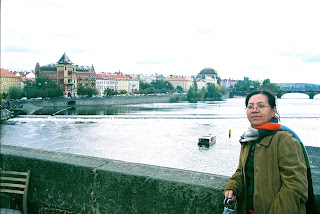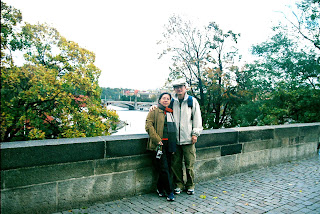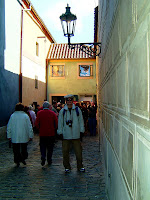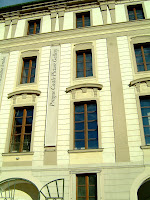
Praque situated along the bank of River Vltava, was a political, cultural and economical center of Czech Republic for 1100 years and now its respective capital. It was the permanent seat of two roman empires during Gothic and Renaissance for many decades. It has a favor geographic position on communication routes between Central and East Europe, North and South Germany and Slavonic area. It offers wealth of architectural, artistic and cultural treasures, combining Czech elements with Jewish and German while having individual charm in each piece of its work. Since 1992, the extensive historical center of Golden Praque has been included in list of world heritage sites, making the city most popular tourist destination in Europe.
Over centuries, the magical city has survived wars and disasters. 1939-1945 the city endured the brutal domination of the Nazis. 1948 after liberated by Russians the country was transformed into a popular republic and marked the birth of Czechoslovakian Socialist Republic in 1960, until lst January 1993 it was then ratified, giving rise to Czech and Slovakia . Praque witness the cultures and civilizations from all over the world.


The remarkable gardens of Ledbour, Cermin, Kolowrat and Pallfy viewed from Praque Castle Complex.



Dome of Church of St. Francis Seraphius at the Knights of the cross and its surrounding scenery.



Old City Square.



A falls colorful pathway to Castle Complex.


Some look-out points to the city



Praque City tram cars and its day traffic.


Buildings of rich architectural design. The Schwarzenberg Palace gives out illusion of diamond-pointed rustication work in fine Renaissance style is now a military museum.



A popular Praque lively puppet shop at bustling corner.



Marvelous sight of the golden city from Charles Bridge.


Charles Bridge, supported by 16 pillars, with a length of 516m and 10m in width, was once part of the defensive works of Praque. It was started building in year 1379 July 9th at 5.31am (13797531 was a palindrome symbolic of a sturdy bridge) to replace the old Judith Bridge which was destroyed several times by flood. It is now a great tourist attraction lined up with artists, craftsmen and vendors to offering their work and finished products like bronze art piece and masks.



Mala Strana was an old home for the German Colonists starting building on 1257. It was a place of nobility and wealth as such the areas are surrounded with many sumptuous palaces and magnificent churches of architectural importance in history. Two towels at Mala Strana were from 12th century and are part of the former old Judith Bridge.



There are 30 statues which were added in 1683 and groups of sculpture, forming a magical atmosphere and attracting crowds of tourists and visitors. A relief bronze carving plaque depicting a scene and place where The Saint Jan of Nepomuk was hurled into Vltava River by order of King Wenceslas IV due to political reasons. Saint Jan was canonized as a martyr and will bring you luck when placing palm on him.


Charles Bridge connects Mala Strana with Stare Mesto and is one of the most beautiful bridges in the world. It is the symbols of excellence in this golden city.



Golden Lane, known as Alchemists Lane was the evidence of the magical city. This picturesque little street is the most charming corner at the Golden City.



Little cottages built around 16th century were to house the guards for Rudolph II.



The little stalls along the short street were once the home to the craftsmen and poor of the city, but now turned into a business sport in sales of local arts, crafts and souvenirs. Each decorative door and window is displayed with owner's design and taste, artistic and attractive.




It is an essential stop for visitors to visit the castle complex. The facade of the gorgeous red St George"s Basilica is just opposite Cathedral at Castle Complex . It was found in 915-921 by Prince Vratislav and is one of the best example of Romanesque architecture.



The Castle of Praque found in 9th century with a combination architecture of Roman, Gothic, Renaissance and Baroque elements, culture and arts, is one of the largest fortresses in the world. It represents the essence of Bohemian City and history memory of the infant Czech Republic.




Cathedral of St Vitus is the most majestic building and largest church in the entire castle complex. It was started building in the year 926 during the period of St Wenceslas and completed in 1929 which was exactly 1000 years after his death. The 47 m long 39 m high Cathedral Chancel was designed and started by M.d'Arras, a french architect, followed by three different architects in 14th, 16th and 18th century, ending up in a combination of style in final.



Cathedral of St Vitus is a master piece of Neo-Gothic architecture.



Royal Palace was built in 12th century originally in romance style but subsequently rebuilt and extended. The magnificent late Gothic vaulting inside Vladislav Hall and over the riders staircase. The original interior of All Saints'Chapel was of the 14th century design.



Royal Palace was built in 12th century originally in romance style but subsequently rebuilt and extended.



The Grand Courtyard.


The elegant Archbishop's Palace was originally a Renaissance residence but extended and converted to Baroque style in 16th to 17th century and to the present Rococo Appearance in 18th century. The palace was bought over by Kind Ferdinand I in 1562 for the Archbishop who returned to Praque at the end of Hussite wars. It is now a gallery and still the Bishop's See today.


The facade of the Cathedral was wedged in between these two steeples which could be captured clearly from the grand courtyard.



Changing of Guards ceremony at the Grand Courtyard in front of the Palace






No comments:
Post a Comment